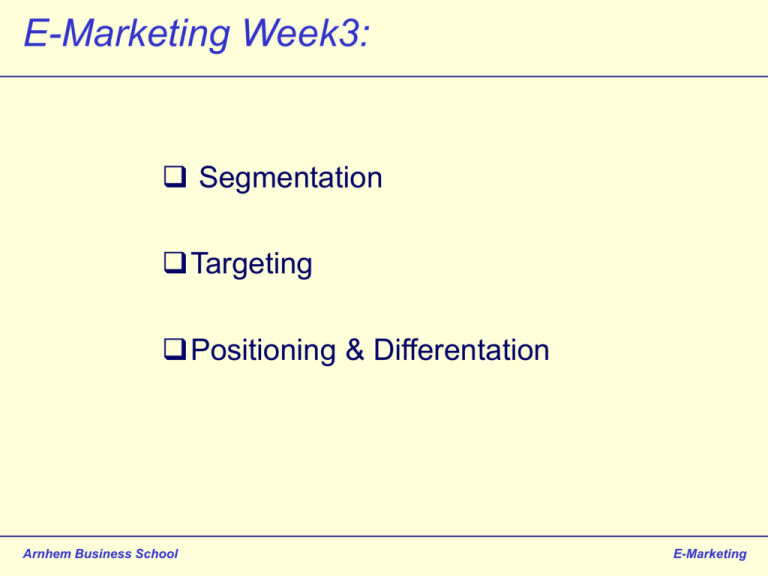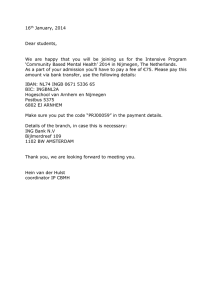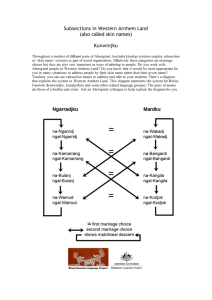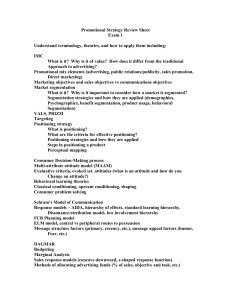EMAR_Week4 - Pc
advertisement

E-Marketing Week3: Segmentation Targeting Positioning & Differentation Arnhem Business School E-Marketing The need for market segmentation Marketers understand that they cannot be all things to all people, all of the time. Buyers and markets are too complex and diverse for one simple marketing formula to adequately address the needs of all. Arnhem Business School E-Marketing Segmentation and positioning Target marketing Identifies market segments that are bite sized chunks that organisations can manage. Market segmentation Identifies markets with common traits. Market targeting Process of evaluation of the selected segments and then deciding which market segments to operate within. Market positioning Process whereby marketers position the product to occupy a clear and distinctive position relative to other competing products. Arnhem Business School E-Marketing Market segmentation Markets are comprised of buyers and they differ in wants, resources, locations and buying patterns. Market segmentation is the process that marketers use to divide up the market into smaller segments that can be efficiently addressed. Arnhem Business School E-Marketing Market segmentation Figure 10.1 Six steps in market segmentation, targeting and positioning Arnhem Business School E-Marketing Levels of market segmentation Mass marketing • Assumes market is homogenous and uses the same product, promotion and distribution to all consumers. Segment marketing • Adapting a company’s offerings so they more closely match the needs of one or more segments. Niche marketing • Adapting a company’s offerings to match the needs of one or more subsegments more closely where there is little competition. Micro marketing • Marketing programmes tailored to narrowly defined geographic, demographic, psychographic behavioural segments. Arnhem Business School E-Marketing Micro marketing Local Marketing Tailoring brands and promotions to the needs and wants of local customer groups. Individual marketing Tailoring products and marketing programmes to the needs and preferences of individual customers. Mass customisation Preparing individually designed products and communication on a large scale. Arnhem Business School E-Marketing Market segmentation There is no single way of segmenting a market. Different market segmentation variables to develop the most effective segmentation method. Major variables used are geographic, demographic, psychographic and behavioural. Arnhem Business School E-Marketing Market segmentation Table 10.1 Market segmentation variables for consumer markets Arnhem Business School E-Marketing Table 10.1 Market segmentation variables for consumer markets (continued) Arnhem Business School E-Marketing Segmentation (1) Geographic segmentation Dividing a market into different geographical units such as countries, states, regions, towns. Demographic segmentation Age and life-cycle segmentation. Ethnic segmentation. Gender segmentation. Income segmentation. Geo-demographics Study of relationship between geographical location and demographics. Arnhem Business School E-Marketing Segmentation (2) Psychographic segmentation Social class Lifestyle • Young and Rubican’s Cross-Cultural Consumer characterisation: The constrained: limited by income, can be ‘resigned poor’ or ‘struggling poor’. The middle majority: ‘aspirers’ and ‘succeeders’. The innovators: ‘transitionals’ and ‘reformers’. Personality traits Arnhem Business School E-Marketing Segmentation (3) Behavioural segmentation Markets segmented based upon consumer knowledge, attitude, use or response to a product. • • • • • • • Occasion segmentation Benefit segmentation User status Usage rate Loyalty status Buyer readiness stage Attitude towards product Arnhem Business School E-Marketing Table 10.3 Benefit segmentation of the toothpaste market Source: Adapted from Russell J. Haley, ‘Benefit segmentation: a decision-oriented research tool’, Journal of Marketing (July 1968), pp. 30–5; see also Haley, ‘Benefit segmentation: backwards and forwards’, Journal of Advertising Research (February–March 1984), pp. 19–25; and Haley, ‘Benefit segmentation – 20 years later’, Journal of Consumer Marketing, 1 (1984), pp. 5–14. Arnhem Business School E-Marketing Segmenting international markets Common segmentation variables used: Geographic location Economic factors Political and legal factors Inter-market segmentation • Form segments of consumers who have similar needs and buying behaviour even if they are in different countries. Arnhem Business School E-Marketing Developing market segments Research based exercise that incorporates several stages: Qualitative research • Exploratory techniques to determine motivations and attitudes. Quantitative research • Structured questionnaire to gain information. Analysis • Factor and cluster analysis. Automatic Interaction Detection and conjoint analysis. Validation • Statistical validation. Profiling • Distinguishing attitudes and behaviours. Arnhem Business School E-Marketing Requirements for effective segmentation Measurability Degree to which size, purchasing power and profits of a market segment can be measured. Accessibility Degree to which a market segment can be reached and served. Substantiality Degree to which a market segment is sufficiently large or profitable. Actionability Degree to which effective programmes can be designed for attracting and serving the given market segment. Arnhem Business School E-Marketing Positioning Core strategy is the matching of company strengths and market opportunities and has 2 components: Identification of group of customers to whom the company can clearly show it has a differential advantage. The firm needs to position its offerings in the customer’s mind. Arnhem Business School E-Marketing Differentiation Marketers strive for competitive advantage defined as a comparative advantage over the competitor gained by offering greater value, either by lower prices or by offering higher quality benefits. Arnhem Business School E-Marketing Differentiating markets Companies and their market offerings can be differentiated along the lines of products, services, personnel or image. Arnhem Business School E-Marketing Differentiating markets (1) Product differentiation Features and benefits Quality Performance Innovation Consistency Reliability Style and design Durability Repairability Arnhem Business School E-Marketing Differentiating markets (2) Services differentiation Delivery Installation Repair services Customer training services Consulting services Speed of service Arnhem Business School E-Marketing Differentiating markets (3) Personnel differentiation Hiring Training Customer focused Arnhem Business School E-Marketing Differentiating markets (4) Image differentiation Images that reflect the ‘soul’ or ethos of the company Arnhem Business School E-Marketing Differentiating markets Value positioning A range of positioning alternatives based on the value an offering delivers and its price. • More for more Premium product and premium price, supported by a premium image. E.g. Mont Blanc pens • More for the same Brand offering comparable quality at a lower price. E.g. Lexus versus the Mercedes-Benz. • The same for less Value proposition e.g. Amazon.com • Less for much less Trade off between luxury and necessity. E.g. Five star hotel versus a budget hotel. Lower performance for much lower cost. • More for less No-name house brands versus the big brands. Arnhem Business School E-Marketing Product Positioning According to Ries and Trout (1981), there are three positioning alternatives: Strengthen a brand’s current position in the mind of the consumers. Search for a new unoccupied position that is valued by enough consumers and occupy that. De-position or re-position the competition. Arnhem Business School E-Marketing Positioning strategies Product attributes Nokia’s 6600 ‘Zoom in’. Technical items BMW breathable fresh air filters. Benefits offered Crest toothpaste reduces cavities. Usage occasions Kit Kat, ‘have a break’. Users Johnson & Johnson changing focus to incorporate adults as frequent users of their gentle Baby Shampoo. Activities Omega, the ‘first and only watch on the moon’. Personalities Tiger Woods for Nike Arnhem Business School E-Marketing Positioning strategies Cult positioning Harry Potter books. Origin Perrier ‘bottled at source’. Positioned with synergistic products and brands Bentley and Breitling. Positioned against competitors Dell and Compaq versus IBM Positioned away from competitors 7-Up the number 1 ‘Un-cola’. Product class membership ‘I can’t believe it’s not butter’, the vegetable fat spread, is clearly positioned against butter. Arnhem Business School E-Marketing Choosing and implementing a positioning strategy Ad man Rosser Reeves states that every company should have a unique selling proposition (USP). The USP is the unique product benefit that a firm aggressively promotes in a consistent manner to its target market. The benefit usually reflects functional superiority: best quality, best services, lowest price, most advanced technology. Difficulty of maintaining functional superiority forces firms to attempt a more emotional influence by developing an emotional selling proposition (ESP). Arnhem Business School E-Marketing Common and serious positioning errors Under-positioning A positioning error referring to failure to position a company, its product or brand. Over-positioning A positioning error referring to too narrow a picture of the company, its products or a brand being communicated to target customers. Confused positioning Leaves consumers with a confused image of the company, its product or brand. Implausible positioning Making claims that stretch the perception of the buyers too far to be believed. Arnhem Business School E-Marketing Essential criteria to accomplish a good positioning strategy • • • • • • • Features and benefits must be important to the consumer. Must be distinctive from the competition. Must deliver superior quality or service. Difference must be communicable and visible to buyers. Pre-emptive and competitors unable to replicate. Affordable Profitable Arnhem Business School E-Marketing








